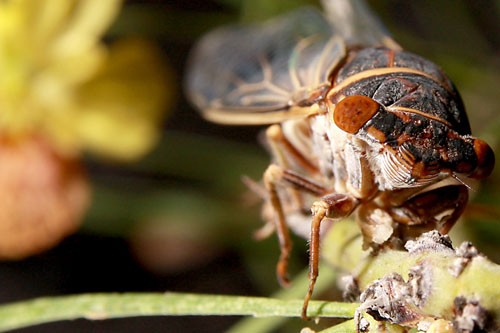When walking around campus, one will probably notice it sounds like Tucson is sizzling.
That sizzling sound is the song of a cicada insect.
“”There is an Australian one I think that maybe breaks glass,”” said Carl Olson, associate curator at the UA department of entomology, also known as “”The Bug Man.”” Olson said the insects can get very loud.
The male cicadas are usually singing to attract the females, but the ones here in Arizona may be unique to the desert climate.
“”The ones that we have here that are out singing right now are the only ones we know of that might sweat,”” Olson said. “”All the males are singing and it allows them to cool off and sing in the hottest part of the day.””
Olson said he usually begins to hear the cicadas at the end of May and into September or October.
It might come as a surprise to know that most cicadas are singing solo.
“”When you hear one, it sounds like a whole bunch, but it is usually only one,”” Olson said, noting that you are likely to only find one insect per tree or bush.
According to Olson, the cicadas are able to use their sound to create an atmosphere that repels predators.
The cicadas in Tucson live in the ground for 3-5 years and live their adult lives above ground for just a few months, according to Olson.
Because the cicadas live in the ground for a relatively short period of time, Tucson has them every summer.
In other locations, cicadas live in the ground for much longer periods of time, causing a very noticeable sound when they emerge.
In Maryland in 2004, cicadas emerged after 17 years in the ground. That year, Jenna Jadin, a grad student at the Univeristy of Maryland, created a cookbook called “”Cicada-Licious: Cooking and Enjoying Periodical Cicadas.””
The cookbook has recipes for cicada-rhubarb pie, cicada stir fry and cicada dumplings.
The size of the cicada depends on the species, and each type of cicada has its own song.
According to Olson, the cicadas in Tucson are typically 2 to 2 1/2 inches long.
“”If you go to the tropics or some other places you get some real monsters,”” Olson said, noting that those cicadas could be up to 5 inches long.
“”They are very efficient in how they create their sound,”” Olson said. “”The way they sing, they have a membrane that has ridges on it and their muscles will contract and cause that membrane to become very tight and snap back.””
Many UA students said they were not bothered by the cicada’s song.
“”They are part of the desert,”” said Dan Pace, a public policy senior.









